You’ve done basic keyword research and written a blog post containing those key terms and related terms. You have covered a few different content angles for the topic for better semantic SEO. Now, you want to know how well you’ve optimized your post and what you can do to improve it further. Or maybe there is a solid blog post or web page you created a while ago, but now its search rankings are going down. With Google’s algorithms changing frequently and new competing articles and pages springing up every day, it has become essential to update and optimize your existing content regularly.
A great option is to run your article through an AI SEO content creation tool. A good AI content creation platform, such as Narrato, will have the right tools to analyze your content and suggest improvements, all while saving hours in the process.
It’s worth a try, don’t you think? See how Narrato’ AI SEO content tools increase the chances of your content ranking on Google.
TL;DR Here’s a quick video summarizing the article
SEO a completed article using Narrato AI
- Generate SEO content brief
- Optimize the SEO content brief
- Discover new keywords and questions with Narrato’s AI tools
- Edit and enhance the content with the in-line AI assistant
- Automate blog publishing with Narrato AI
- Narrato AI for SEO meta descriptions
- Narrato AI for content outlines
- Narrato AI for FAQs
- Narrato AI to repurpose content

SEO a completed article or web page using Narrato AI
To SEO a published article on your blog, you will first need an SEO content brief explaining the SEO requirements for the particular piece of content. An SEO brief includes the title, outline, keywords, word count, sources (references), style guide (target audience, tone of voice, grammar rules, target readability score etc.), and any additional notes to create or update content to expectations.
The point of an SEO brief is to help writers create quality posts that will rank sufficiently well to generate organic traffic. It is also handy in improving content that has already been written. However, when done manually, the brief provides guidance only and does not help assess your content’s SEO score.
That’s why you need Narrato AI which generates an SEO content brief and also gives you an SEO score based on how closely your content aligns with the SEO brief.
The process: generate an SEO brief for your article topic, paste your article on the Narrato editor, check the SEO score, and optimize the content based on the brief to improve your score, with a little help from Narrato’s AI templates and in-line AI assistant. See Narrato AI in action below.
Generate SEO content brief
To generate an SEO content brief on Narrato, you simply need to paste your article title on the SEO content brief generator and click “Generate”. The SEO brief for your topic will be generated within seconds.
Here’s the SEO brief for one of our existing articles “How to Use AI for Amazon Product Descriptions”. You can see the keywords for the topic, questions to answer, references, and structuring suggestions like the number of words, headings and paragraphs to target.
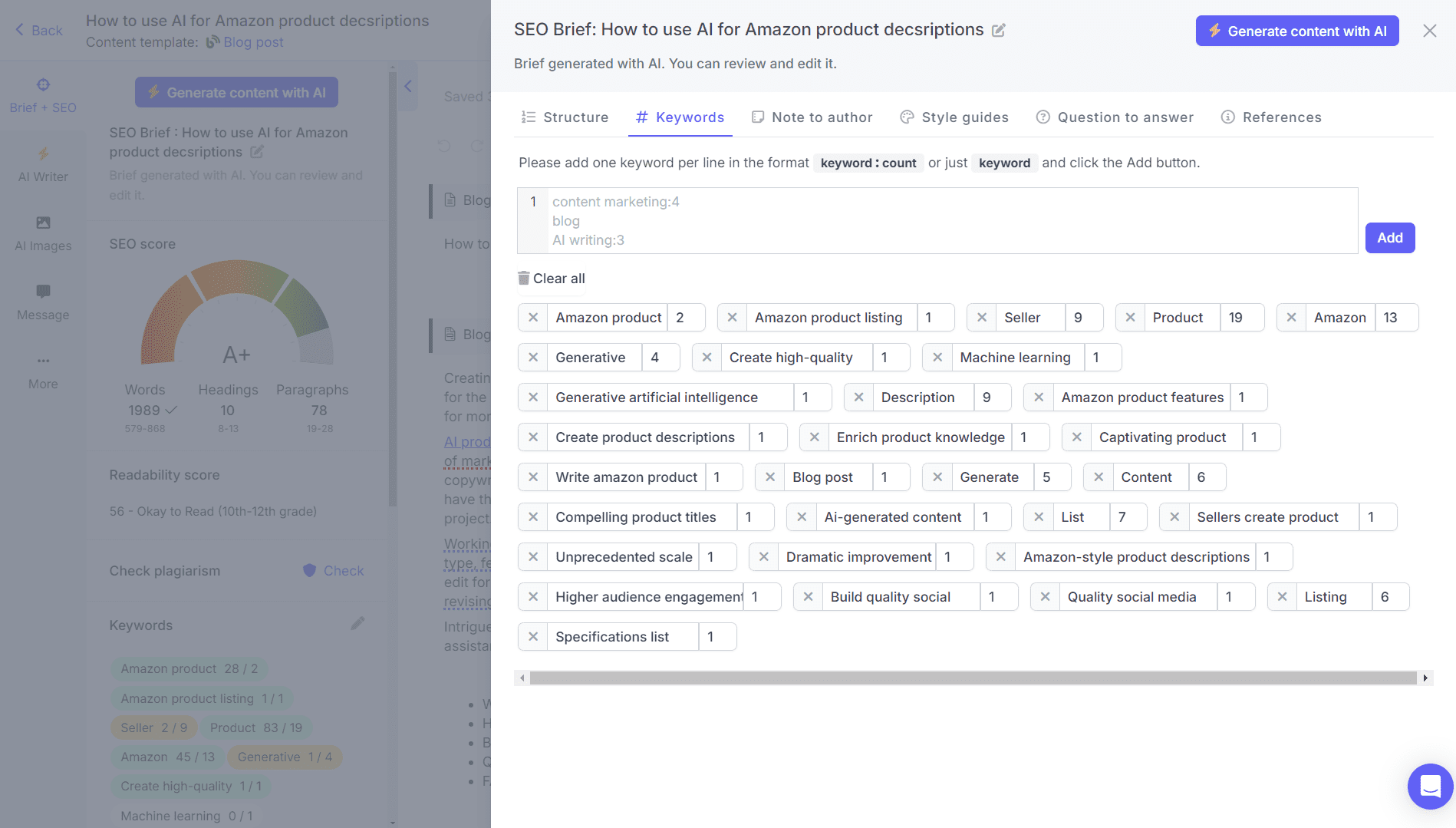
Optimize the SEO content brief
The next step would be to optimize the brief itself. You can delete or add keywords as required. For instance, the keywords highlighted in red are unnecessary to the article, so we will delete these and add any relevant keywords if they are already present. You can change the keyword counts as well.

Discover new keywords and questions with Narrato’s AI tools
If you need help for further keyword research, you can use the AI keyword generator. You will find this tool under the SEO category on the AI writer or type “search keywords” on the search bar.
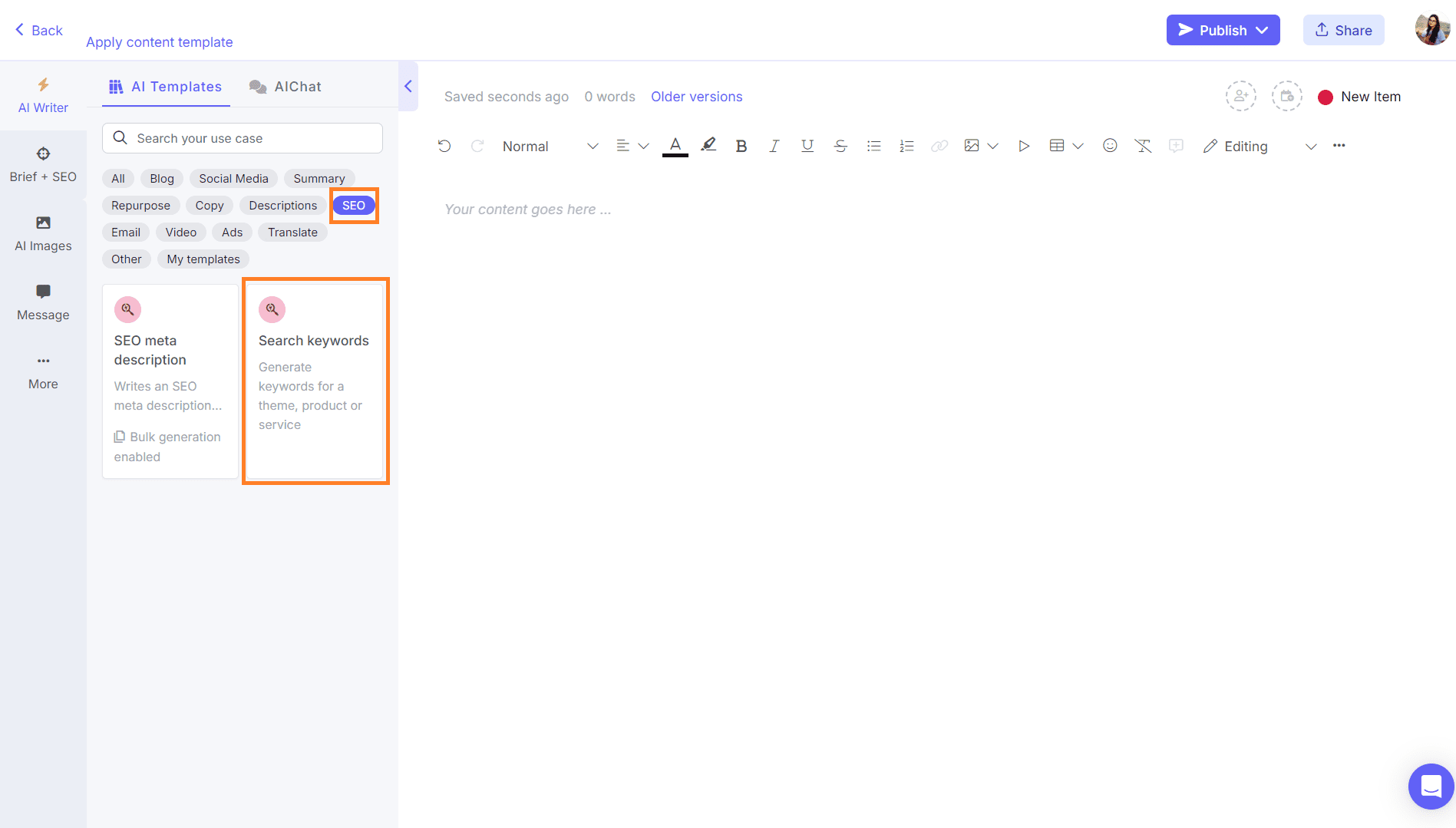
Add the topic and generate keywords, as seen below. It will give you a long list of keywords sorted by search volume, along with the average searches per month for each keyword. It’s a good idea to run these keywords on Google Keyword Planner to verify the volumes.
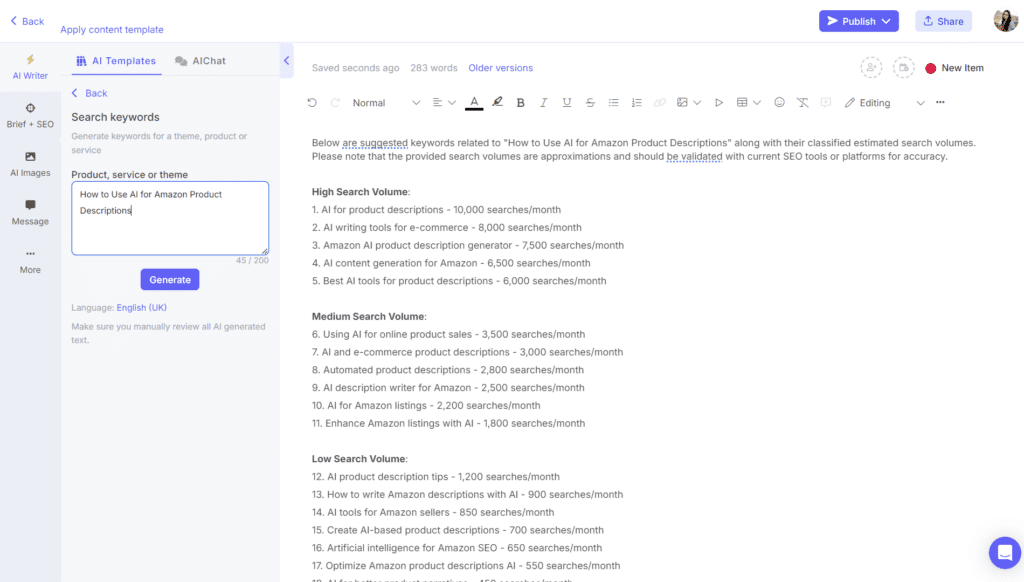
Then, you want to take a look at the ‘questions to answer’ section (seen below) to understand if the article covers the common questions around your topic that people search on Google. Handily, Narrato AI also generates references to give you more material and benchmark against competing articles.
If the questions on the brief don’t cut it (though they mostly should, as these are picked from PAA and related searches on Google) you can use Narrato’s AI FAQ generator to add some of your own.
Now that you have the updated and enhanced SEO brief ready, it’s time to start optimizing the article. We copy-pasted our article on the Narrato editor. Not bad, the article is already rated ‘A’. But we’d love for it to be an A+.

We need to see if adding more keywords can increase the score. Including keywords from the brief in your article will highlight the keywords on the brief in orange and then, in green, upon reaching the recommended density of the key terms.

Try and incorporate as many of the keywords as you can in your content.

Edit and enhance the content with the in-line AI assistant
Narrato’s in-line AI assistant will also help you with edits, automatically improving, shortening, expanding, summarizing, or simplifying text. For instance if you want to expand or rewrite a certain section, just click on the use case on the drop down, and the rewritten content will be generated right below your selected text.
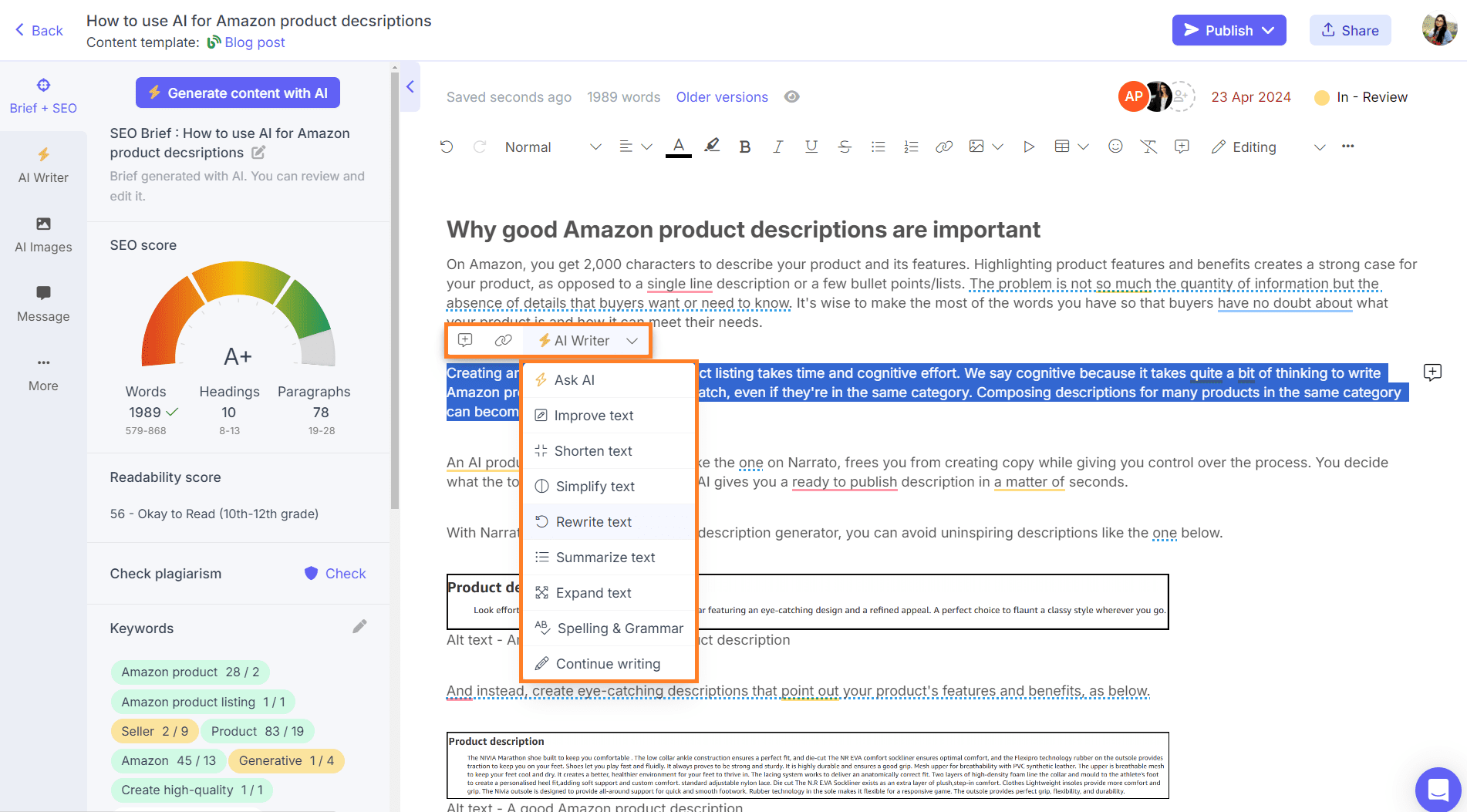
After making changes to your article as per the SEO brief, you should see an A+. This means your content is optimized for most of the keywords, is of the right length, and meets the other parameters laid down by the brief as well.
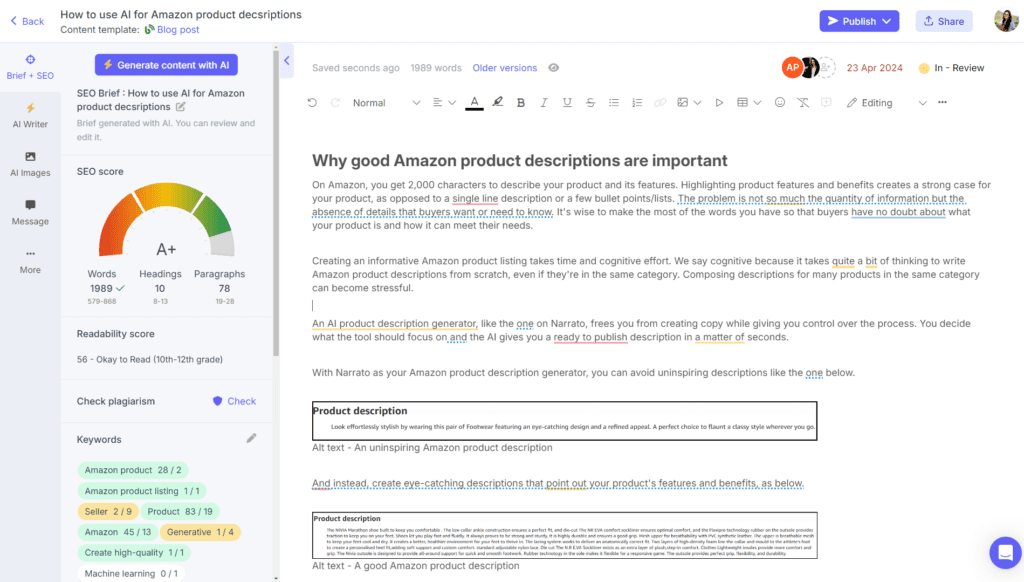
Automate blog publishing with Narrato AI
If you plan to republish the existing blog post or web page as a new piece, you can publish your content directly from Narrato AI to WordPress, Webflow or any other CMS. For instance, if you’re hosting your blog on WordPress, you’ll have to first link your WordPress account to Narrato using a few simple steps.
Once linked, simply click on the Publish button on the content task, select WordPress.
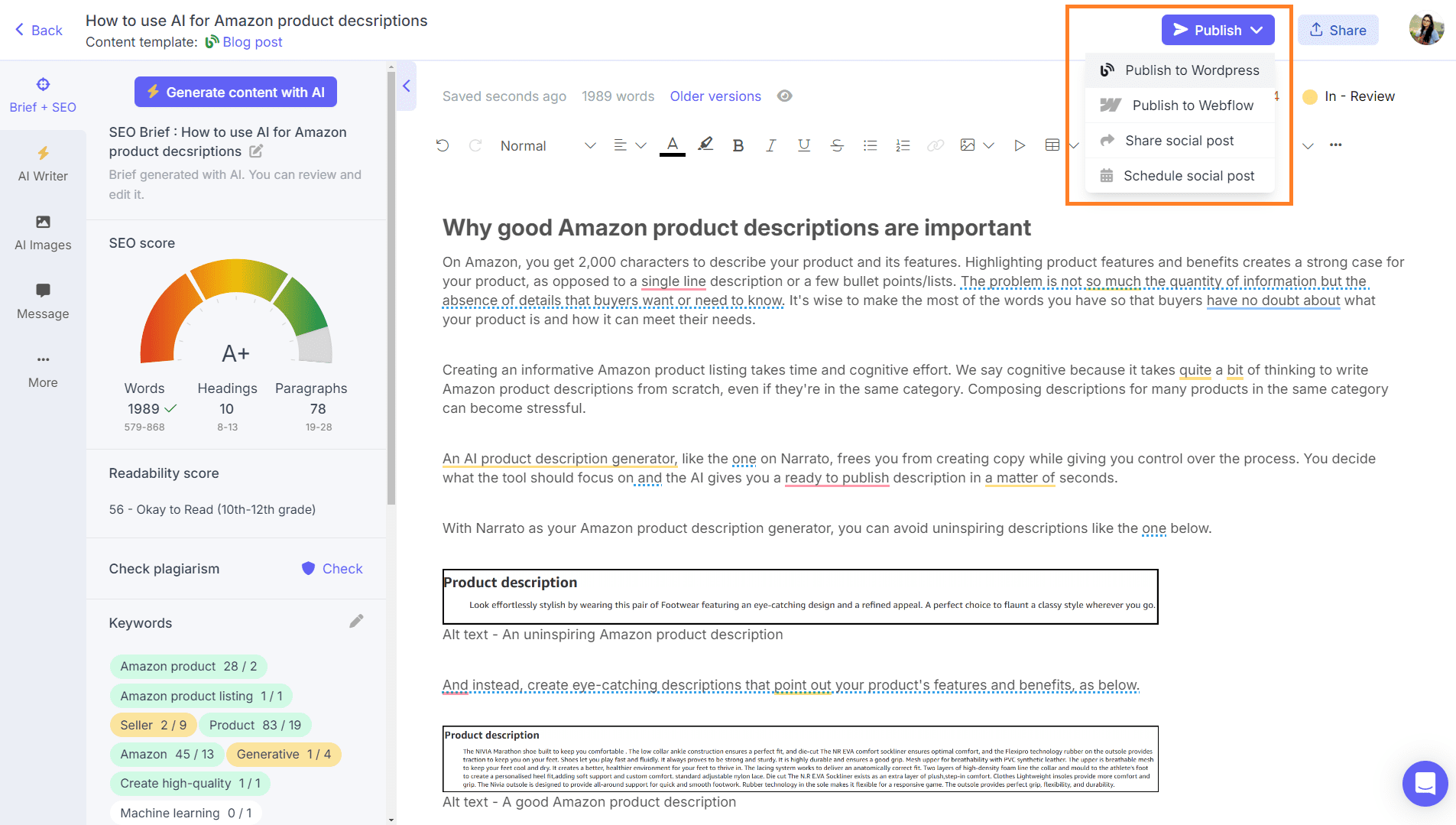
Choose the right options for WordPress username, content type, and post status, and publish.

Narrato also integrates with Zapier. If you’re on Zapier, you can publish content automatically to your CMS and connect your Narrato workspace with thousands of other apps.

Other AI SEO tools on Narrato
Apart from the SEO content brief generator and the AI keyword generator, there are a lot of other tools on Narrato that may help you in your search engine optimization efforts. Here are a few you might want to try.
Narrato AI for SEO meta descriptions
Narrato has an AI SEO meta description generator too. It generates SEO meta titles and descriptions based on page title/topic, keywords, and tone of voice. It’s a time saver when you need to publish a post ASAP or you’re behind deadline. You can also use the tool to bulk generate SEO meta descriptions for multiple pages at once. In a CSV sheet, create ‘Page Title/Topic’, ‘Keywords’ and ‘Tone/Brand Voice’ headings and copy-paste the details, and the AI bulk content generation feature will do the rest. It can save you hours of work in your SEO efforts.
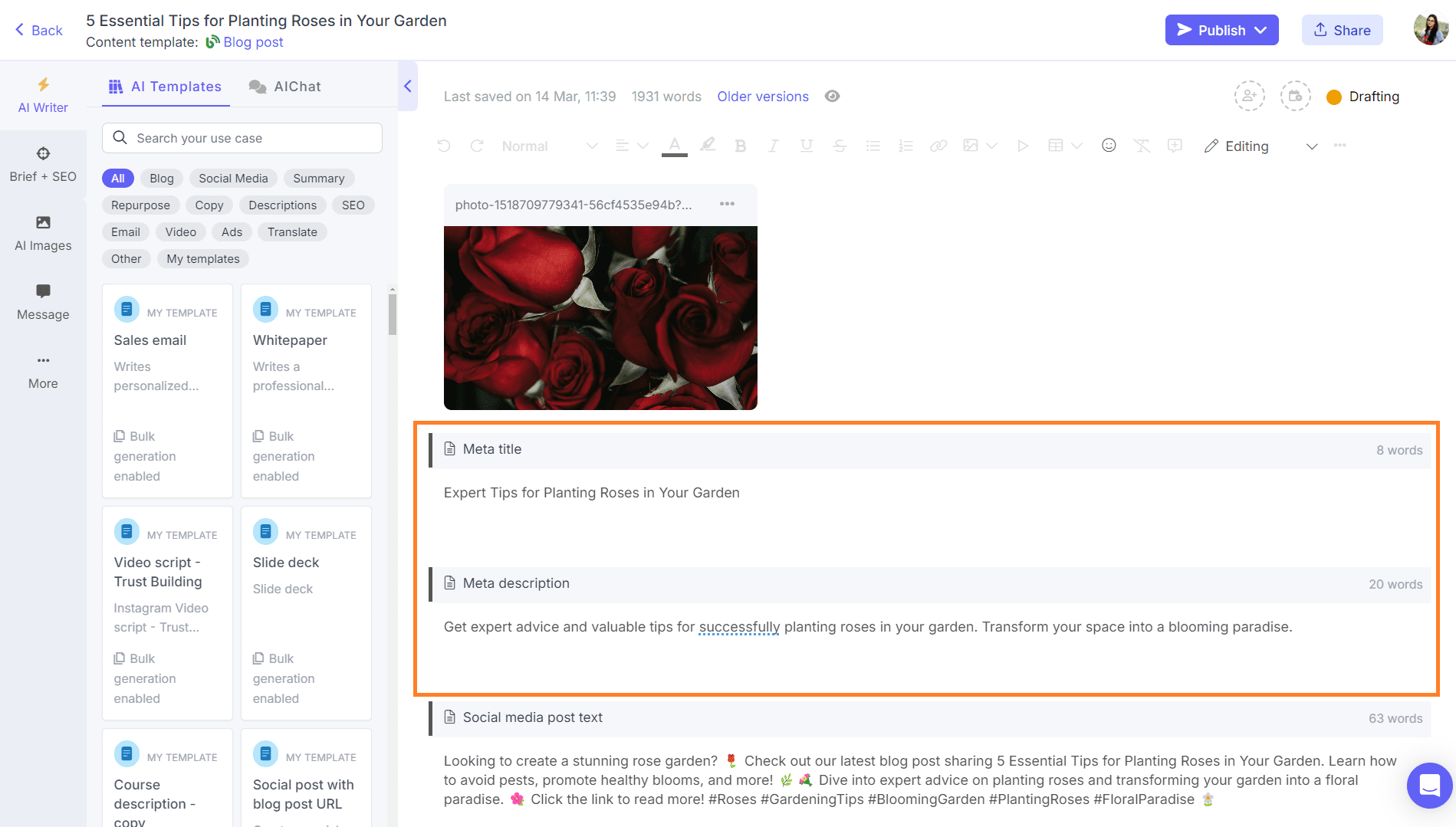
Narrato AI for content outlines
A content outline lays out what your content will include. It includes headings and subheading (H2s, H3s, H4s).
An outline is an effective way to ensure that your article includes sub-topics that satisfy searchers’ intent and answer the commonly asked questions by your audience. Developing an outline before writing an article is pretty much a foolproof way to make your article flow from idea to idea in a logical sequence. You can avoid writing far too much about one idea or forgetting to include an important idea in your article. Outlines provide the framework for your article so it turns out organized and cogent.
Article outlines are great for helping writers on your team write articles efficiently and to the desired SEO and writing requirements. They give you more control over the quality of your content, but most of us often skip this essential step because it feels like too much effort or time-consuming.
Narrato AI generates content outlines in seconds. It creates blog post, landing page, email, and newsletter outlines like a breeze. Let’s try generating an outline for ‘How to use AI to create Amazon product descriptions’. Supply the blog title and choose the tone of voice/brand voice, and your outline will be ready in a snap.
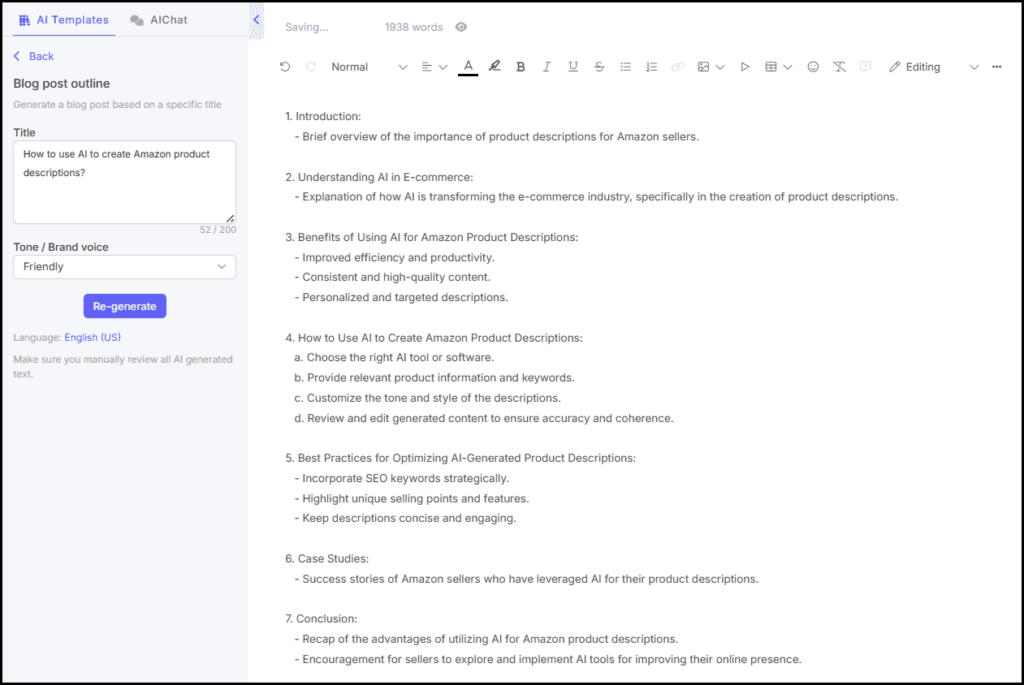
Narrato AI for FAQs
FAQs help users find the information they need quickly and easily. They are incredibly beneficial not only for users but also for search engines. When you include frequently asked questions on your website, search engines are able to gain a deeper understanding of your content. This, in turn, enhances the overall visibility and relevance of your website. So, FAQs serve a dual purpose by being helpful to both users and search engines alike.
There are dedicated FAQs pages, but they’re also added to blog posts and web copy to improve SEO. The questions in FAQs are similar to the long-tail keywords people search for on Google. Incorporating key terms in your SEO, you can rank higher for more keywords and drive more traffic to your website.
FAQs provide your audience with a better understanding of your products or services. They’re pithy 2-3 line answers to the often-asked questions about a particular type of service/product or the product/service itself, if it has been around for a while. Visitors to your page will be interested in those burning questions, and spend more on the page, helping decrease your website’s bounce rate.
Another benefit of using FAQs is that they can make you show up on Google’s coveted features snippets, which are hard to miss. Snippets are often displayed prominently at the top of the search engine results page, catching the user’s eye immediately. The beauty of featured snippets lies in their ability to provide direct answers to users’ inquiries. If your FAQs are useful, they can appear on Google’s featured snippets and boost your organic search results.
The AI FAQ generator is yet another reason Narrato is counted among the most versatile content generation tools. Simply provide the topic and Narrato AI will generate FAQs, as shown below.
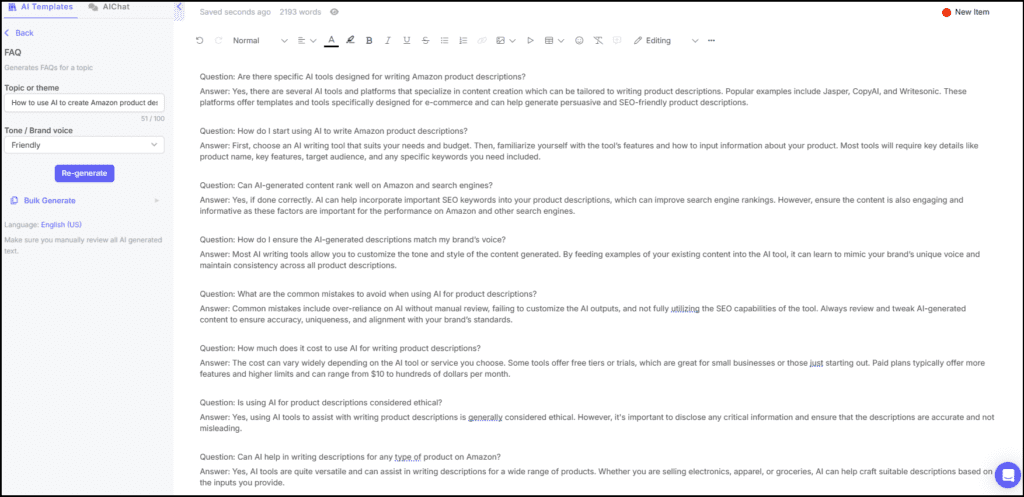
Narrato creates 8-10 FAQs. Depending on your requirements, you can keep all of them or just the most important ones. As you can see, the answers generated are crisp and to the point. If you want more options in FAQs, write the same topic in different words and see if you like the new set. You can modify your topic to get a variety of FAQs and select the best ones from multiple batches.
Narrato AI to repurpose content
Repurposing has many benefits beyond time savings. It is a great SEO tactic too. Narrato’s AI content repurposing tool can repurpose your articles and web pages for wider distribution on any channel. It can create blog posts from videos, social media posts from blog posts, summaries of podcasts, and more.
Some of your audience may be dedicated readers of your blog, others may be subscribers to your YouTube channel or podcast. Why not transform your content into different formats to appeal to the needs of different audience groups? The chances that audiences will engage with your content are higher when it is in their preferred format and on their preferred online haunts.
Repurposed content comes before potential customers over and over again, in different formats. It is a way to put into action the marketing rule of 7, according to which brands need to engage with customers seven times to earn their trust and business. Repurposing your SEO content offers multiple opportunities for engagement with the important message or topic you want to communicate to your target audience.

Narrato AI is your SEO driver
SEO content creation can get overwhelming quickly in the absence of smart time-saving hacks. AI content creation tools make content writing more efficient and SEO-friendly. Narrato AI is among the content creation tools that helps save more time for strategic and creative SEO tasks. AI-generated content is fast becoming the norm and complementing human authorship.
Apart from SEO writing with AI and optimizing existing content for search engines, the tool also assists in overcoming writer’s block, content ideation, and planning. Whether you’re an entrepreneur, a small team, or a large writing department, you can enhance your content creation process with Narrato. Create high-quality content at scale, make it easy for your writers to stick to your SEO content guidelines, and find the time to explore trends and opportunities in the evolving landscape of content marketing!
Also Read: How to Humanize AI Content with These Simple Hacks
FAQs
1. How can I use Narrato AI to enhance my meta descriptions for SEO?
Narrato AI creates compelling and keyword-rich meta descriptions for blog posts and webpages. The descriptions are crucial as they appear in search engine results and can influence whether someone clicks on your link or not.
2. What should I do if Narrato does not provide satisfactory results?
An artificial intelligence tool’s output depends heavily on the prompt/input it receives. Try adjusting your prompt on Narrato’s AI template and check the results. If you’re still unhappy, combining AI-generated drafts with a human editor’s touch can often produce the best results.
3. Can’t I manage with ChatGPT?
ChatGPT’s use cases for SEO are numerous and valuable. But it lacks the features that make Narrato a true AI SEO content assistant. Generating SEO scores, keywords, and web sources, and repurposing content, Narrato takes care of all your important SEO content needs. From educational posts and eCommerce product descriptions to web copy and sales enablement content, and bulk SEO meta description generation, Narrato AI can save time on SEO and creating marketing content as a whole.
4. How does Narrato AI assist with improving content readability for better SEO?
Narrato AI evaluates the readability of your content by checking sentence structure and complexity. It enables you to more easily target your AI-generated content to your audience, whether they’re executives or average consumers.





